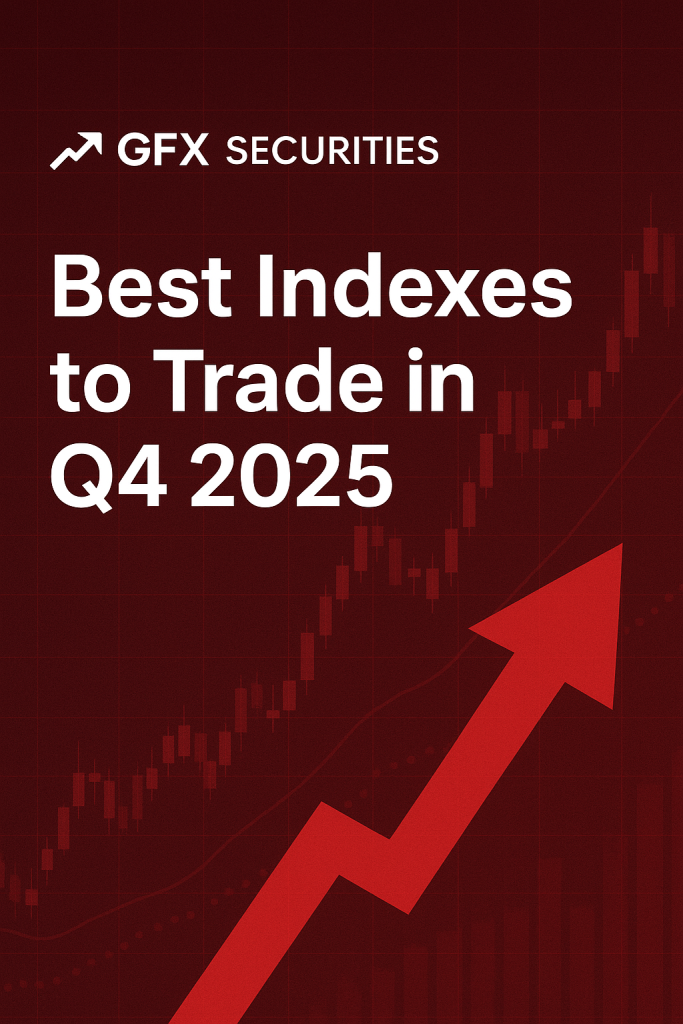Best Index CFDs to Trade in Q4 2025 for Profitable Setups
Powered by GFX Securities
Introduction
Q4 is historically one of the most active and opportunity-rich periods for index traders. With macro shifts expected in late 2025 — from central-bank policy normalisation to AI-driven sector rotations — traders should prioritise liquidity, volatility, and structural trends when choosing which indices to trade. This guide highlights the best indexes to trade in Q4 2025, how to trade them, and practical ideas you can run on GFX Securities.
Quick takeaways
S&P 500 / US large-cap indexes — best for liquid, directional plays driven by earnings and AI spending.
Nasdaq 100 — ideal for momentum and tech/AI exposure; higher volatility, higher reward.
DAX (Germany) — a top pick for macro/event-driven traders in Q4, sensitive to ECB policy and European growth data.
FTSE 100 — defensive play with commodity and banking exposure; useful during risk-on/risk-off rotations.
Nikkei 225 — excellent for traders seeking exposure to the Japan reopening and export-driven cycles.
Hang Seng / China-focused indices — trading windows for event-driven volatility (policy. regulatory news, reopening).
Why these indexes matter for Q4 2025
Q4 2025 will likely be shaped by the interaction of corporate earnings (especially AI-related capex), central bank signals on rate cuts or pauses, and geopolitical risk that can spike safe-haven flows. The S&P 500 and Nasdaq continue to draw liquidity because of large-cap tech leadership, while regional indices (DAX, Nikkei, Hang Seng) can offer outsized moves when local macro or policy events surprise markets.
Trade ideas and setups
1) S&P 500 (SPX) — earnings-driven directional trades
Why trade it: Exceptional liquidity, low spreads, and clear correlation with macro/earnings beats. Use index futures or CFDs to take directional views around major earnings and macro releases.
Suggested setups: momentum breakouts on daily closes, mean-reversion after intraday spikes, earnings straddles with options.
2) Nasdaq 100 (NDX) — momentum and sector rotation
Why trade it: Concentration in AI and large-cap tech means bigger swings — great for trend-followers.
Suggested setups: trend-following strategies with ATR-based stops, long-leaning strangle option plays during earnings season.
3) DAX — event-driven swings around European data & ECB
Why trade it: High beta to European industrials and auto sector; sensitive to ECB commentary and Eurozone data releases.
Suggested setups: trade ECB decision windows with straddles; use macro calendar to target volatility spikes.
4) FTSE 100 — income/defensive rotation play
Why trade it: Heavier exposure to commodities and banks; often outperforms during commodity rallies or when risk-off sentiment boosts dividends and bank yields.
Suggested setups: pairs trades vs S&P to capture regional divergence; use ETFs or CFDs for carry strategies.
5) Nikkei 225 — export-driven momentum
Why trade it: Benefits from global tech cycle and yen moves; sensitive to currency (JPY) policy and trade flows.
Suggested setups: trade index vs USD/JPY cross to hedge currency exposure; use breakout strategies on monthly timeframes.
6) Hang Seng / China indices — higher-risk, event-driven opportunities
Why trade it: Regulatory updates, policy stimulus, or reopening effects can create sharp directional moves and volatility.
Suggested setups: focus on event windows and intraday volatility; widen stops and size down to manage risk.
Risk management & position sizing
Limit index exposure to a fixed % of account equity per trade (example 1–3% risk per trade).
Use ATR-based stops or options for defined risk.
Consider hedging cross-market exposure (e.g., S&P long vs FTSE short) to reduce systemic risk.
Execution on GFX Securities
Use tight spreads and deep liquidity on S&P and Nasdaq products for intraday and swing trades.
Take advantage of 24/5 market coverage, advanced order types, and risk management tools available on the GFX platform.
Use our calendar feed for earnings, central bank events, and economic releases to time entries.


